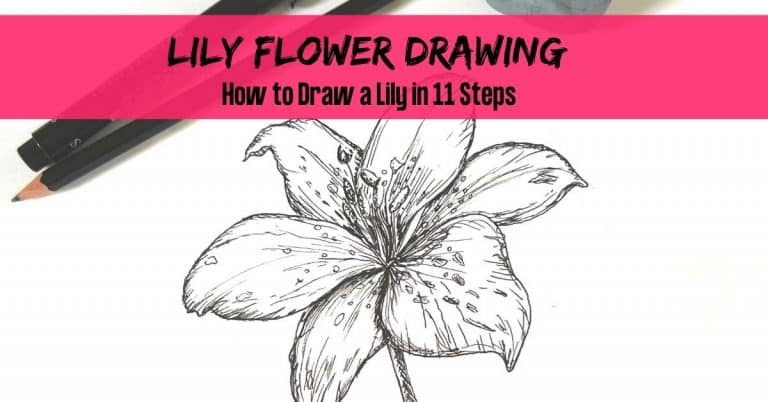Last Updated on January 5, 2023 by Dee
Do you want to learn how to draw a lily? This step-by-step tutorial will help you achieve a beautiful lily flower drawing in no time 🙂
In this tutorial, we will be using pencils and paper. You can use any type of paper that you like, but I recommend something with a smooth surface so the pencil markings will be easier to see. Let’s get started!
Lilies are true beauties when it comes to flowers. They are explosive in their color and shape – and it’s easy to be amazed by the sheer variety of the lily species.
While white lilies symbolize purity, red lilies symbolize forever love. Pink lilies symbolize femininity and innocence, and because of the Greek myth of Hera and Zeus, lilies are linked to rebirth and motherhood.
They are magnificent flowers to draw so whatever your reason – have fun!
[Related Article: Pen & Watercolor Flowers Tutorials]
So, how do you go about drawing these beautiful flowers?
Let’s begin!

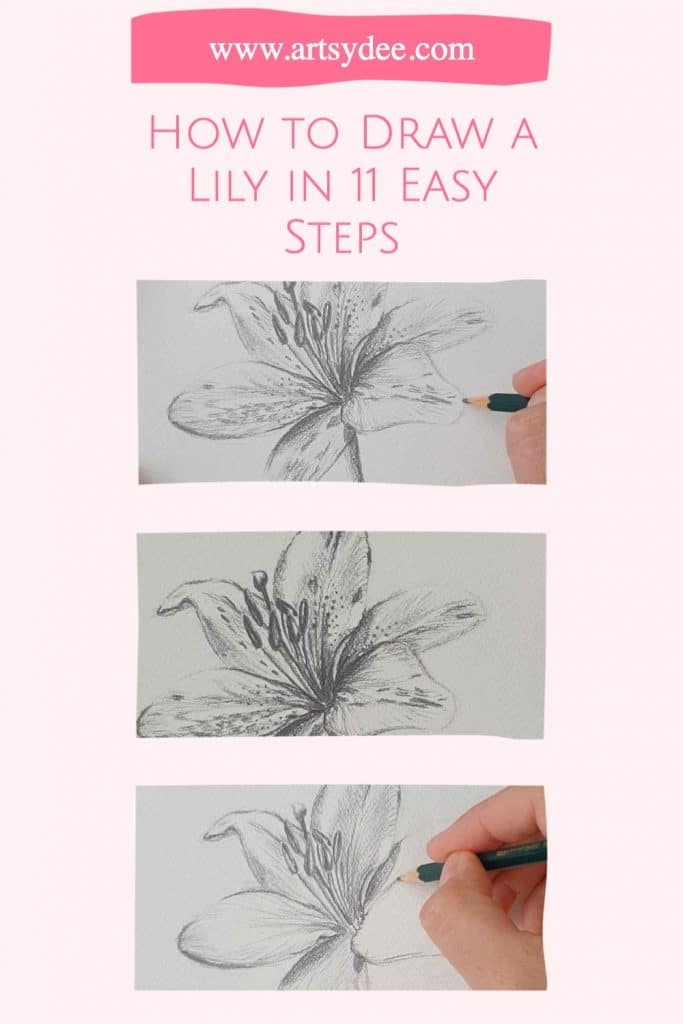
Lily Drawing: Step by step
**This page may contain affiliate links to products I have used or recommend. If you purchase something from this page, I may receive a small percentage of the sale at no extra cost to you.**
Have you ever looked at a lily and wondered how something so beautiful could exist? While their appearance may seem effortless, lilies are quite intricate flowers in reality. In this article, I’ll walk you through the process of drawing a lily flower.
Step 1- Collecting your reference material
Whenever you paint a plant or flower, it is a good idea to get a clear and good-quality reference image to work from. There are so many beautiful photos to draw a lily from so go ahead and browse on Unsplash.com or Pexels.com.
Work from your imagination
You can work from your imagination, but the truth is that most people’s brains leave out important information about the original flower. As a result, the flower may be more stylized or simplified than the original.
[Related article: How to Get Ideas for Drawing: 31 Ways to Find Unique Ideas]
If you want to paint a flower or plant more abstractly or expressionistically, working with a more stylized, simplified drawing is absolutely fine. In this case, drawing from your imagination would work well.
In this drawing tutorial, I wanted to capture the smaller details of the lily flower, as well as the soft, pink, feminine aesthetic.
Work from your OWN photos
Drawing from your own photos is a great way to develop unique ideas and compositions. You also have first-hand experience with what the lily looks like in a real-life situation. This gives you a better idea of how the subject matter “sits in space’ so to speak.
Work from a free stock photo
Because I wanted a level of naturalism in my artwork, I chose to work from a photograph of a lily that I found on unsplash.com.
If you cannot get your own photographs of your chosen subject matter, you can always use free images from unsplash.com or pexel.com. There are many free stock photo sites on the web, but these two are the ones I have used the most for good reference photos.
[Related article: 121 Fun and Easy Objects to Draw]
Step 2: Decide on the size of your lily drawing
I find that working on an A4 or A3 sheet of watercolor paper is a good size to start with for botanical art. The lily I painted is on an A4 sheet of paper.
I recommend sticking to at least A4 in size because if you work any smaller, you may struggle to get a good amount of detail in your drawing or painting.
Interestingly, working on a larger surface is much easier than on a smaller surface.
Working on a larger sheet of paper means you can accentuate details and enlarge tiny areas. Your brush strokes can be wider, and there is more room for error.
Step 3: Composition and a rough drawing of the general shapes of the lily
Once you have decided on the paper size you will be working on; you can think about your composition and then draw it out in pencil.
Start by drawing a small circle in the center and adding a curved line to draw the first petal. Continue to add curved lines to create the first two petals, the fourth petal, the fifth petal, and the final resulting shape. Draw the stem by sketching two lines parallel to one another.
Think carefully about how you will position your Lily flower on your page. It’s a good idea to position your subject matter off-center to make your artwork more interesting.
I recommend using a 2B lead pencil to softly sketch out the general shapes of the lily’s petals, leaves, and stem. Each lily petal is composed of two curved lines that form the petal shape. Make sure you apply only a very light pressure onto the pencil to achieve very light pencil marks on the page.
At this angle, a lily and it’s petals fit into an oval shape.
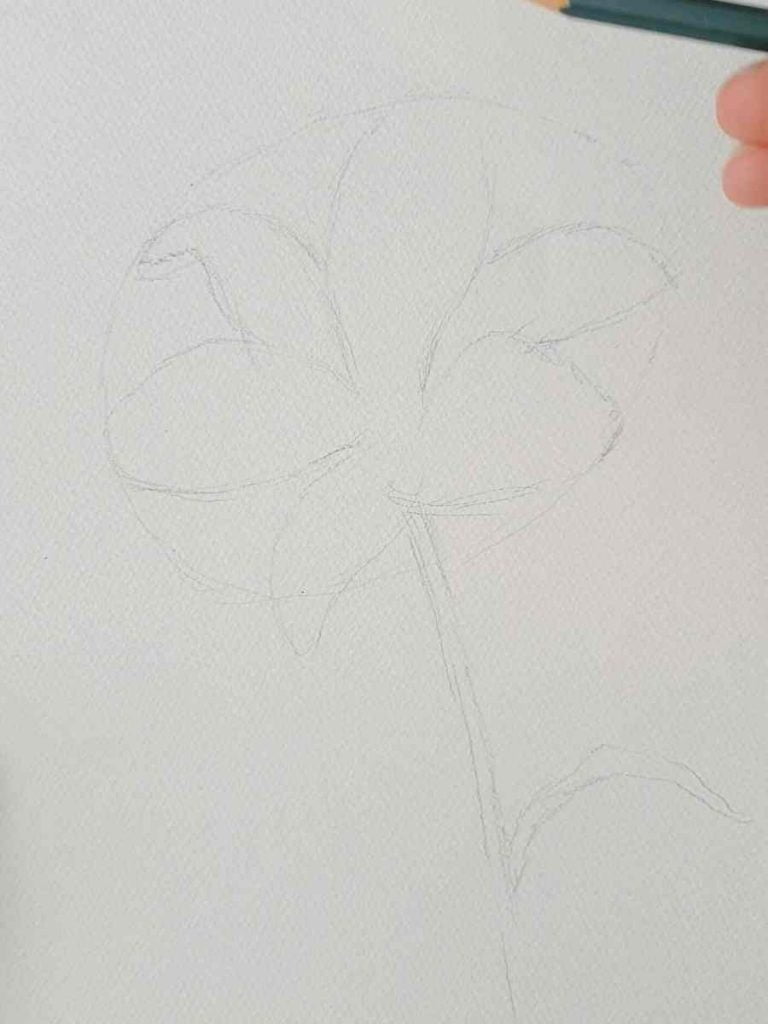
Step 4: Defining Form
Once you have sketched the light general shapes of the lily, you can start going over the petals, stem, and leaf again and making changes and alterations to your shapes to make your subject matter look more accurate.
At this stage of the process, you can also use your artistic license to add elements like additional leaves, stems, or buds to your artwork to complete the composition.
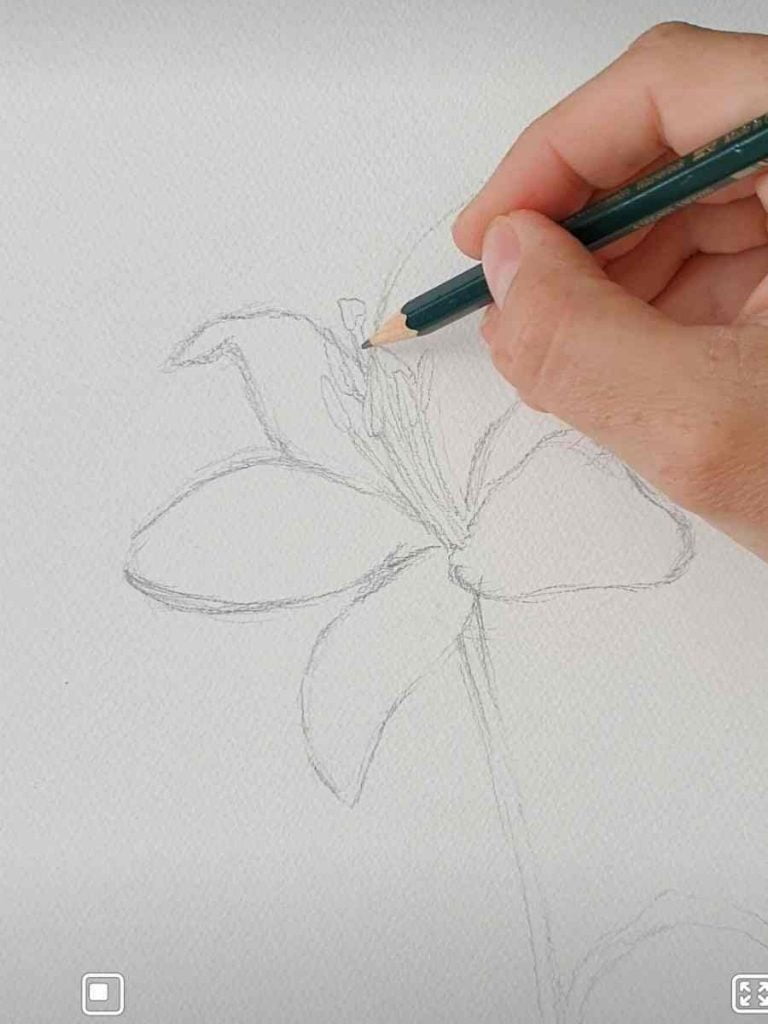
Step 5: Add shading
Remember to check where your light source is! To draw a realistic lily, you need to capture the three-dimensionality of the flower. This is so important to draw forms accurately and get a sense of three-dimensionality. Your shadows will fall opposite your light source.
You can use several shading techniques to shade in your lily flower – cross-hatching, hatching, scribbling, stippling, and grading.
[Related Post: How to Improve your Drawing…Follow These Top Tips!]
I personally find that using a combination of shading techniques to build up the density of form and deepen my shadows works really well.

Step 6: Continue shading and add the markings to the petals
Continue to deepen your shading and shadows and add pattern-like spots to your tiger-lily petals.
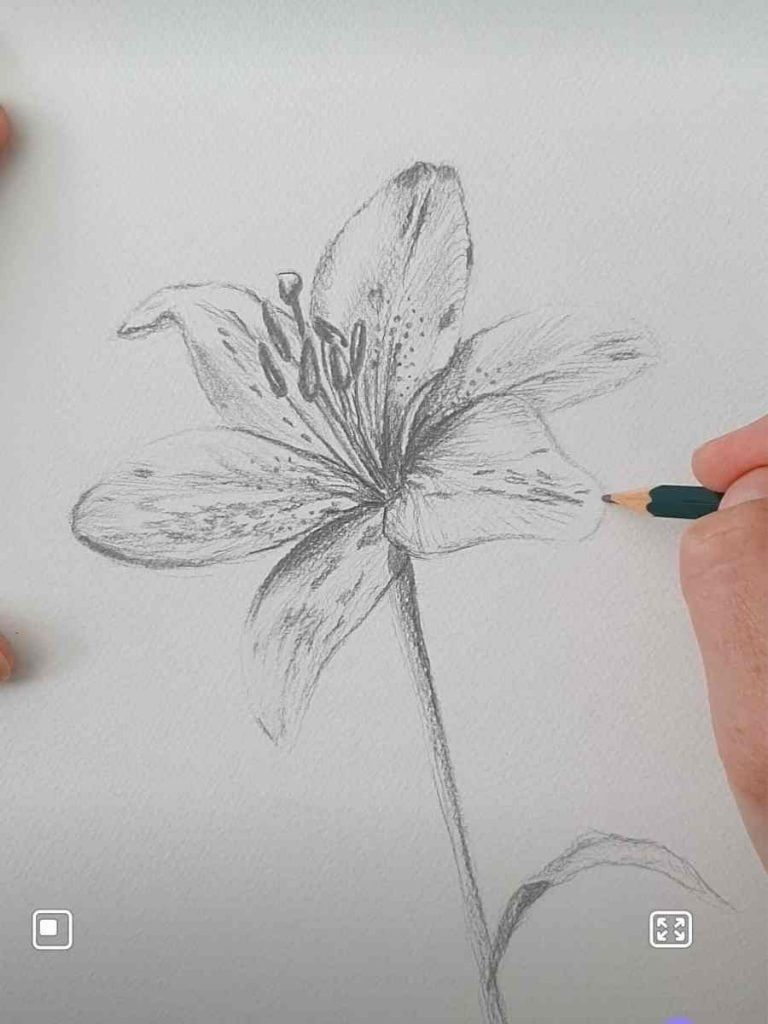
Step 7: Final Details
Carefully observe your drawing and deepen any shadows that need to be darker while lightening your highlighted areas. You can use your kneadable eraser to pick up pencil marks to lighten specific areas.
If you want to take your pencil drawing a step further, you can add color to the lily by applying soft washes of watercolor paint over the pencil.
Leaving the pencil mark visible gives the drawing a retro and vintage quality to it, and it can be effective!
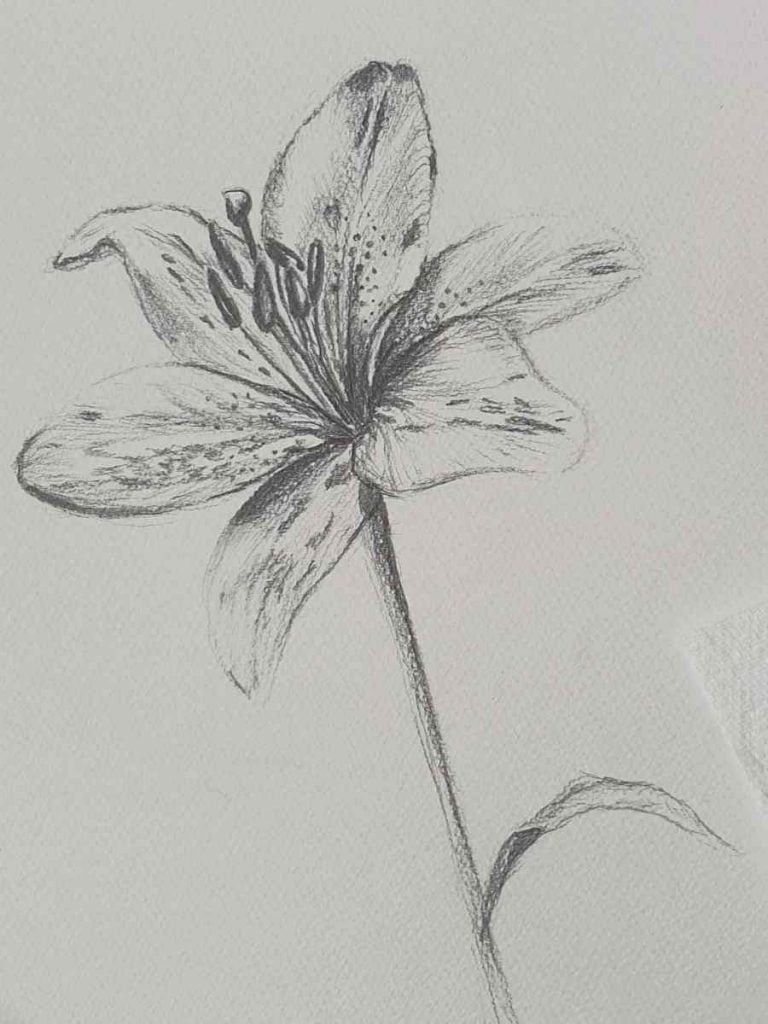
Step 8: Paint washes of your lightest color
As you begin painting with watercolor, you will use a wet-on-dry technique. Essentially that means you are putting paint on your paintbrush and then painting directly onto the dry surface of the page. This is a good way to start because you have more control over the areas you are painting color.
Once you have defined your shapes using your initial color, you can work into them using a wet-on-wet technique.
Wet on wet is where you paint you paint your watercolor paint onto a watery surface. The color then blooms and bleeds and creates interesting washes of color. This is less controlled than wet-on-dry, but I love watching how the watercolor pigment creates gorgeous textures and patterns as it dries.
I started by painting very soft washes of rose pink over the lily’s petals. Follow the petal line.
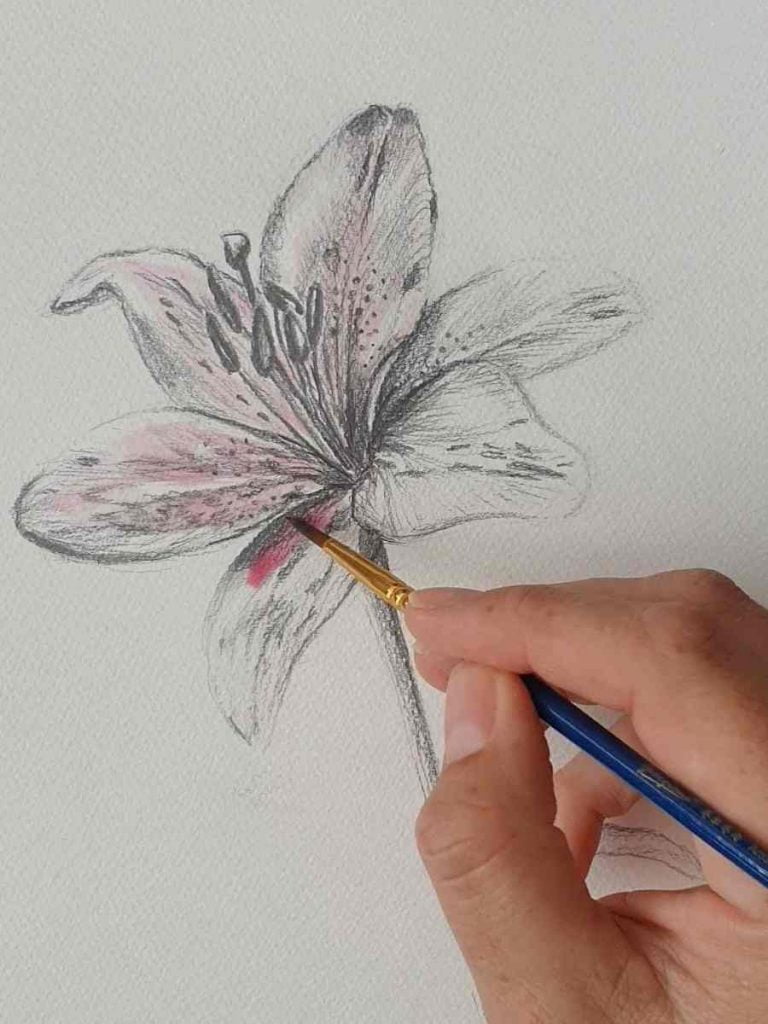
[Related Post: How to Paint Gorgeous Cherry Blossoms]
Step 9: Layers of washes to darker areas of the flowers
Continue to paint layers of washes on top of one another to build up depth and deepen shadow areas.
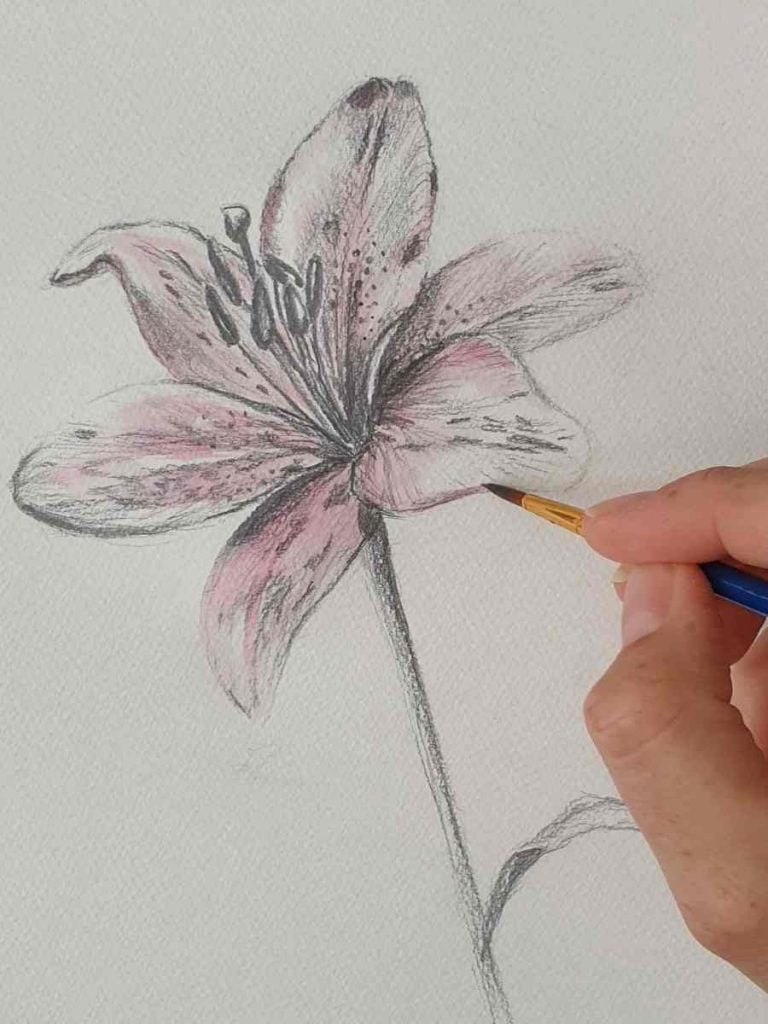
Step 10: Washes of green on the stems
Paint light washes of green on the stem.
Step 11: Final Patterns onto Petals
Using the Alizarin Crimson paint small dashes and dots of color and gently wash over them to create a soft pattern on the lily’s petals.
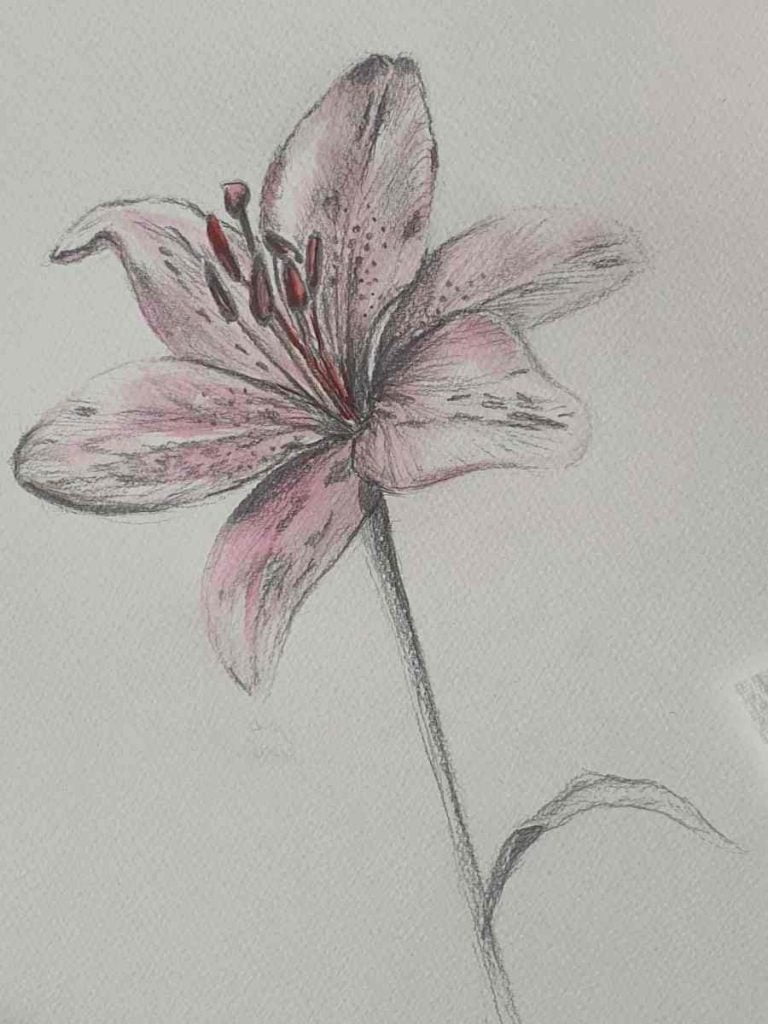
Remember the following when drawing…
Make sure to stand back regularly to observe how your drawing is developing. You must also give yourself mental and visual breaks to continue to draw accurately.
Remember to keep your pencil sharp. This is important because often we get so engrossed in our drawing that we forget that a sharp pencil helps with fine lines and details.
Having a scrap piece of paper nearby is always a good idea to test your shapes and shading techniques!
List of materials and supplies needed to draw a beautiful Lily Flower
The Best Painting and Drawing Supplies for Artists2B, 4B, 6B, and 8B Pencil
Kneadable Eraser
Scrap piece of paper for testing colors
300gsm Watercolor Paper: If you want to add a wash to your drawing you should do your drawing on good-quality, heavy paper that doesn’t buckle.
Soft Bristle Round or Filbert Brush
Watercolor pans or tubes. I am currently using the Windsor and Newton Watercolor Pan. The colors are rich, and the tray is portable and easy to use.

Conclusion
Drawing a beautiful lily flower is easy with the right instructions. By following the eleven simple steps in this tutorial, you can create your own beautiful lily flower drawing. Once you have mastered this basic drawing technique, you can experiment with different flowers and leaves to create your floral sketches. Have fun with it!
Other drawing tutorials you may enjoy…
Exquisite Rose Drawing | 3 Easy Step-by-Step Tutorials
25 Fabulous Flower Templates | FREE Printables for Your Creative Projects.
Flower Crown Drawing | How to Draw a Delicate Flower Crown in 12 Steps
How to Do a Realistic Sunflower Pencil Drawing
59 Aesthetic Things to Draw: Art Ideas for Creative Minds
136 Drawing Ideas for Adults | Unleash Your Creativity
